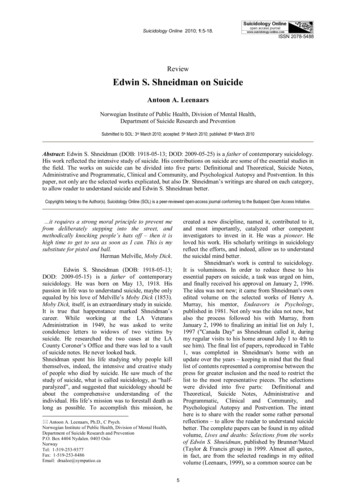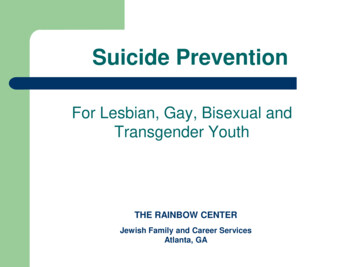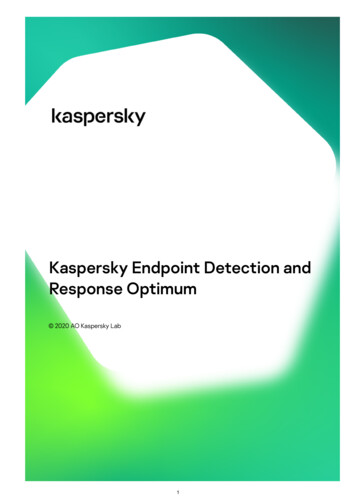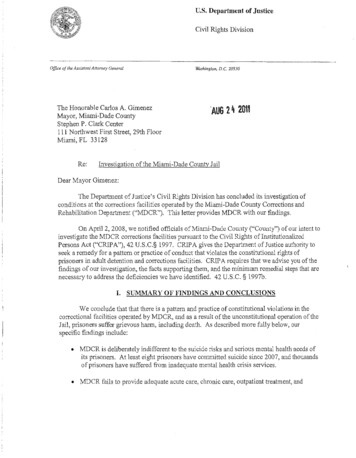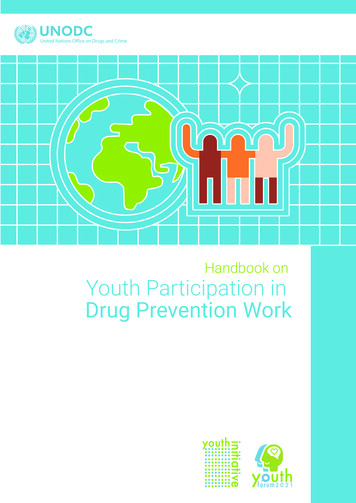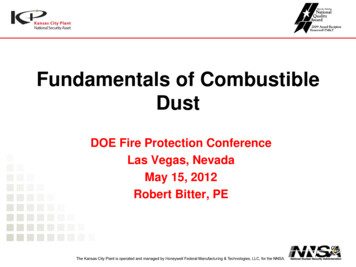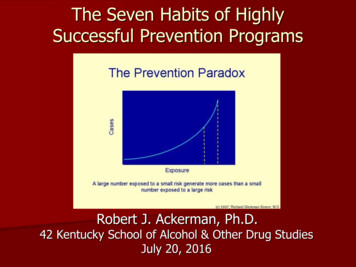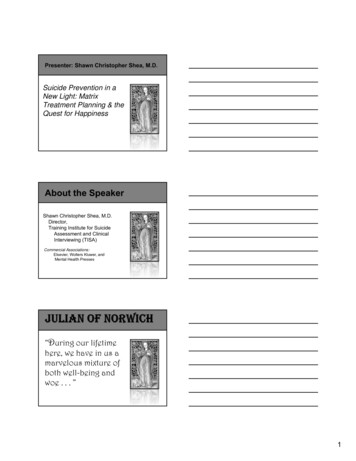
Transcription
Suicide Prevention in aNew Light: MatrixTreatment Planning & theQuest for HappinessShawn Christopher Shea, M.D.Director,Training Institute for SuicideAssessment and ClinicalInterviewing (TISA)Commercial Associations:Elsevier, Wolters Kluwer, andMental Health Presses“During our lifetimehere, we have in us amarvelous mixture ofboth well-being andwoe . . . ”1
“All is well, andevery kind ofthing will be well.”2
Suicide Prevention in a New Light: Matrix Treatment Planningand the Quest for HappinessPresenter:Shawn Christopher Shea, M.D.I. IntroductionA. Philosophy as an integrating tool and guide for unstalling stalled treatment plans.B. Two core philosophical questions that will be used to better integrateand enhance the practical usefulness of the bio-psycho-social-spiritualmodel1. What is happiness?2. What is the nature of human nature?C. The utility of translating the bio-psycho-social-spiritual model into a patientfriendly model - the human matrix - that is easily understood,compelling in nature, and can serve as a basis for patient education,shared communication, collaborative treatment planning, and self-growth.D. Emphasis is upon practical clinical tools for everyday practice with a focus uponunstalling stalled treatment planningII. Quest for the Meaning of Happiness: What is happiness?"Happiness is like a sunbeam that the least shadow interrupts."unknown Zen MonkA. The quest for a definition of happiness1. John Merrick and Sir Frederick Treves (our Victorian guides to the natureof happiness)2. Western mysticisma) Julian of Norwich (14th Century English mystic and anchorite)"During our lifetime here, we have in us a marvelous mixture of bothwell-being and woe . . . And now we are raised to the one, and nowwe are permitted to fall to the other."Julian of Norwich"Another conviction quickly arose; It was that each positive emotion andits negative antithesis indeed constitute one quality rather than two . . . inthe same way that the dark colors in a painting give beauty and contrastto the pastels, the negative emotions are equally necessary to give depthand meaning to the positive ones; that one could not truly appreciatelove without first knowing hate, or beauty without having seen ugliness,or any positive emotion without awareness of its antithesis."Jane Dunlap (aka Adelle Davis)
2B. Operational definition for use in clinical work that views happiness as notonly a feeling but as an attitude and a feeling combined (Shea; 2004)"Happiness is the attitude we call trust - a profound trust - accompaniedby a reassuring feeling of confidence that one can effectively handlewhatever life may bring, good or bad. This attitude of trust allows oneto live in the present moment in which there are no frets about the pastor worries about the future. This feeling of confidence is pleasant,refreshing, and steadfast."C. Clinical ramifications1. Psychotherapya) Utility of asking patients to define their concept ofhappiness and the implications of what this means in terms oftherapeutic goals, length of therapy, and effective use of timesessions available.b) Particular use when working with dependency issues2. Role in treatment of patients with severe and persistent mental illnessa) Shifting from a paradigm where the emphasis is almost solelyupon symptom relief to a paradigm that focuses equallystrongly on symptom relief but adds the importanceof helping patients to live and cope with those symptomsthat cannot be relieved (e.g. to maximize their happinesswhile coping with persistent symptoms).b) Client Vignette "The Man Who Needed to Hear"III. Inside the Human Matrix: What is the structure of human nature?A. Introduction to the "human matrix" model of human nature as adaptedfrom the bio-psycho-social-spiritual model - the "Quantum World View."B. Differences between human matrix model and bio-psycho-social-spiritualmodel.1. Increased emphasis on the interactivity between the various fields.2. Treatment planning emphasizes attempts to change one fieldby interventions on a different field.3. Remarkably more user friendly and understandable to patientsenhancing initial and ongoing collaborative treatment planning.C. Basic language and principles of human matrix as used as a treatmentplanning model.1. human matrixa. Definition: The human matrix is a model of human nature thatviews a human being as the net interaction of five constantlyshifting and interacting systems including: the biological system,the psychological system, the interpersonal system, theenvironmental system, and the spiritual belief system2. matrix effectsa. A change on one system automatically causes a change ina different system3. healing matrix effect
3a. A matrix effect that creates a beneficial effect for the patient(e.g. a psychological intervention such as psychotherapy changes theactual biochemistry or structure of the brain as seen with OCD andbrain scans of the basal ganglia following successful interventionwith CBT).b. understanding and enhancing placebo effects4. damaging matrix effecta. A matrix effect that creates a damaging effect for the client(e.g. a change in the biological system damages the social andinterpersonal system as seen with the behavioral disruptionscaused by a frontal lobe tumor).5. Red Herring Principlea. Because of the interdependence of the systems and the role ofdamaging matrix effects, a problem in one system may cause suchsevere problems in a different system that clinicians and clientsare fooled into focusing their efforts on the wrong system (e.g. failinggrades attributed to a lack of motivation on the psychological system of astudent may actually be the result of a social system problem - domesticviolence - or of the biological system - attention deficit disorder).6. Maximizing Matrix Principlea. No matter which system is the etiologic problem, attemptsare made to maximize the functioning of all systems with thehope of generating distant healing matrix effects (a patient withmarital problems is taught deep relaxation techniques that mayhelp improve resiliency and openness to change in the maritaltherapy).D. Treatment planning and improving engagement and medication adherenceby using the human matrix model.1. The Power of Placeboa. Leuchter's work suggesting that placebo actually changed brainpathophysiology in patient's with major depressions via EEG analysisb. Educational impact - training clinicians in the "talisman effect"2. Client Vignette: "The Man Who Was His Apartment""But every man is more than just himself; he also represents the unique,the very special and always significant and remarkable point at whichthe world's phenomena intersect, only once in this way and never again.That is why every man's story is important, eternal, and sacred . . ."Herman Hesse(from the novel Demian)IV) Questions and Comments
4ReferencesMain sources from which the talk was culled:Shea, S. C.: Happiness Is.: Unexpected Answers to Practical Questions in Curious TimesHealth Communications, Inc., Deerfield Beach, Florida, 2004.Shea, S. C.: Assessment perspectives: Pathways to effective treatment planning.Chapter 4 from Psychiatric Interviewing: the Art of Understanding, 2nd Edition,W. B. Saunders Company, Philadelphia, 1998.Other Clinical Books by Dr. SheaShawn Christopher Shea, Improving Medication Adherence: How to Talk with PatientsAbout Their Medications (Lippincott Williams & Wilkins) 2006Shawn Christopher Shea, The Practical Art of Suicide Assessment (John Wiley & Sons,Inc.) 2002Shawn Christopher Shea, Psychiatric Interviewing: the Art of Understanding, 2nd Edition(W.B. Saunders) 1998Christian Mysticism and PhilosophyManuela Dunn, Christian Mysticism (Hyperion) 1998Ursula King, Christian Mystics, the Spiritual Heart of the Christian Tradition(Simon & Schuster Editions) 1998Julian of Norwich, Revelation of Love (Image Books/Doubleday) 1997Fiona Maddocks, Hildegard of Bingen (Image Books/Doubleday) 2003Mother Teresa, Meditations from a Simple Path (Ballantine Books) 1996Classic Books of SpiritualityAlan McGlashan, Savage and Beautiful Country - the Secret Life of the Mind(Hillstone) 1967Sam Keen, To a Dancing God - Notes of a Spiritual Traveler (Harper San Francisco)1990M. Scott Peck, The Road Less Traveled - A New Psychology of Love, TraditionalValues and Spiritual Growth (A Touchstone Book/Simon & Schuster)1978T. Byram Karasu, The Art of Serenity - The Path to a Joyful Life in the Best andWorst of Times (Simon & Schuster) 2003Jon Kabat-Zinn, Wherever You Go There You Are - Mindfulness Meditation in EverydayLife (Hyperion) 1994
5Eastern ReligionStewart W. Holmes and Chimyo Horioka, Zen Art for Meditation (TuttlePublishing) 2002Chang Chung-yuan, Creativity and Taoism - a Study of Chinese Philosophy, Art, andPoetry (Harper Torchbooks) 1963C. Scott Littleton, Shinto - Origins, Rituals, Festivals, Spirits, Sacred Spaces (OxfordUniversity Press) 2002Alan WattsAlan Watts, The Meaning of Happiness (Harper & Brothers Publishers) 1940Alan Watts, The Book On the Taboo Against Knowing Who You Are (Vintage Books)1989Alan Watts, Taoism: Way Beyond Seeking (Tuttle Publishing) 1997Alan Watts, The Culture of Counter-Culture (Tuttle Publishing) 1998Alan Watts, Cloud-Hidden, Whereabouts Unknown (Pantheon Books) 1973Quantum Mechanics and Modern PhysicsFritjof Capra, The Tao of Physics, 25th Anniversary Edition (Shambhala) 2000Thomas J. McFarlane, editor, Einstein and Buddha (Seastone) 2002James Gleick, Chaos - Making a New Science (Viking) 1988Neurobiology and PhilosophyJeffrey M. Schwartz and Sharon Begley, The Mind and the Brain - Neuroplasticityand the Power of Mental Force (Regan Books) 2002Michael Reagon, editor, Inside the Mind of God (Templeton Foundation Press) 2002Obsessive-Compulsive Disorder (OCD)Jeffrey M. Schwartz and Beverly Beyette, Brain Lock - Free Yourself fromObsessive-Compulsive Behavior (Regan Books) 1996Placebo EffectR. Fuente-Fernandez et al., Expectation and Dopamine Release: Mechanism ofthe Placebo Effect in Parkinson's Disease, Science, volume 293, 2001Andrew F. Leuchter et al., Changes in Brain Function of Depressed Subjects DuringTreatment with Placebo, American Journal of Psychiatry, volume 159,
6January 2002Helen s. Mayberg et al., The Functional Neuroanatomy of the Placebo Effect,American Journal of Psychiatry, volume 159, May 2002Victorian England and John MerrickWolf Von Eckardt, Sander L. Gillman and J. Edward Chamberlin, Oscar Wilde'sLondon - A Scrapbook of Vices and Virtues: 1880-1900 (Anchor Press,Doubleday & company Inc.) 1987Roger Hart, English Life in the Nineteenth Century (G. P. Putnam's Sons) 1971Karl Beckson, London in the 1890s - A Cultural History (W. W. Norton &Company) 1992Ashley Montagu, The Elephant Man - A Study in Human Dignity (Outerbridge& Dienstfrey, distributed by E. P. Dutton & Co.) 1971* * * * * * * *
Speaker: Shawn Christopher Shea, M.D.About the SpeakerShawn Christopher Shea, MDDirector, Training Institute for Suicide Assessmentand Clinical Interviewing (TISA)www.suicideassessment.com(603) 763-0536Commercial Associations Published author receiving royalties from:Elsevier, Wolters Kluwer, andMental Health PressesSUICIDE ASSESSMENT PROTOCOLRisk andProtective FactorsSuicidal Ideationand IntentClinical Formulationof Risk1
SUICIDE ASSESSMENT PROTOCOLRisk andProtective FactorsSuicidal Ideationand IntentClinical Formulationof RiskSADPERSONSScalePatterson, W. M., et. al., 1983“SAD PERSONS” Scale SexAgeDepression2
“SAD PERSONS” Scale Previous attemptEtoh abuseRational thought lossSocial supports lackingOrganized planNo spouseSicknessNOHOPEAcronymShea, S. C., 1988“NO HOPE” Acronym No framework for meaning Overt change clinically3
“NO HOPE” Acronym Hostile interpersonal environmentOut of hospital recentlyPredisposing personality disorderExplanation for dyingIS PATHWARMAcronymRudd, M. D., et al., 2006“IS PATH WARM”Acronym Ideation Substance abuse4
“IS PATH WARM” Acronym PurposelessnessAnxietyTrappedHopeless“IS PATH WARM” Acronym WithdrawnAngerRecklessnessMood disorderSpeaker: Shawn Christopher Shea, M.D.5
Speaker: Shawn Christopher Shea, M.D.About the SpeakerShawn Christopher Shea, MDDirector, Training Institute for Suicide Assessmentand Clinical Interviewing (TISA)www.suicideassessment.com(603) 763-0536Commercial Associations Published author receiving royalties from:Elsevier, Wolters Kluwer, andMental Health PressesSUICIDE ASSESSMENT PROTOCOLRisk andProtective FactorsSuicidal Ideationand IntentClinical Formulationof Risk6
SUICIDE ASSESSMENT PROTOCOLRisk andProtective FactorsSuicidal Ideationand IntentClinical Formulationof RiskEquation of Suicidal dIntentVALIDITY7
7 Validity Techniques1) Normalization2) Shame Attenuation3) Behavioral Incident4) Gentle Assumption5) Denial of the Specific6) Catch-All Question7) Symptom AmplificationEvolution of Interviewing TrainingInterviewing principlesInterviewing techniquesInterviewing strategiesCopyright : Shawn Christopher Shea 2010Illustration of an Interviewing PrincipleBefore you raise a sensitive or a tabootopic, meta-communicate to the clientthat it is okay to talk about the topic.8
Validity Techniques for Raisinga Sensitive Topic1) Normalization2) Shame metimeswhen people are asdepressed as you’ve been feeling theyfind themselves having thoughts ofkilling themselves; have you beenhaving any thoughts like that?”9
Illustration of an Interviewing PrincipleBefore you raise a sensitive or a tabootopic, meta-communicate to the clientthat it is okay to talk about the topic.Shame Attenuation(Shea)SAtShame Attenuation“With everything you’ve been going through,have you been having any thoughts of killingyourself?”“With all of your pain, have you been having anythoughts of killing yourself?”10
Empathic ResonanceThe words “killing yourself”1) How does the concept of suicide firstenter a client’s mind?2) Cultural baggage of the word “commit”Second Style of Shame Attenuation withRationalization: Used When UncoveringAntisocial Material1) Intuit client’s rationalization2) Frame question through the eyes of the clientEvolution of Interviewing TrainingInterviewing principlesInterviewing techniquesInterviewing strategiesCopyright : Shawn Christopher Shea 201011
Validity Techniques for ExploringSensitive Topics Once Raised1) Behavioral Incident2) Gentle Assumption3) Denial of the Specific4) Catch-All Question5) Symptom AmplificationBehavioral Incident(Gerald Pascal)BI2 Styles of Behavioral Incidents1) Fact-finding behavioral incident2) Sequencing behavioral incident12
Gentle Assumption(Pomeroy)GAGentle Assumption“Whatother ways have you thought ofkilling yourself?”Denial of the Specific(Shea)DS13
Denial of the Specific Used forUncovering Suicidal Plans1) “Have you been having any thoughtsof shooting yourself?”2) “Have you been having any thoughtsof jumping off a bridge or a building?”3) “Have you been having any thoughts ofoverdosing?”Technical Tip: Avoid Cannon Questions“Have you been having any thoughts ofshooting yourself, jumping off a bridge orbuilding, or overdosing?”Always ask one DS at a timeTypical Trigger to Initiate the Useof Denials of the SpecificGADS14
Catch-All Question(Shea)CaQSymptom Amplification(Shea)SASymptom Amplification#15
Symptom Amplification#15Symptom Amplification#15Symptom Amplification#15PINT16
Symptom Amplification Used WhenUncovering Suicidal Thought“Onyour very worst days, how muchtime do you spend thinking about killingyourself - 70% of your waking hours,80% of your waking hours, 90%?”7 Validity Techniques1) Normalization2) Shame Attenuation3) Behavioral Incident4) Gentle Assumption5) Denial of the Specific6) Catch-All Question7) Symptom AmplificationVideoDemonstration17
7 Validity Techniques1) Normalization2) Shame Attenuation3) Behavioral Incident4) Gentle Assumption5) Denial of the Specific6) Catch-All Question7) Symptom AmplificationHow frequently have bossestaken you aside, you knowharped on you, complainingabout your work?How frequently have bossestaken you aside, you knowharped on you, complainingabout your work?18
How frequently have bossestaken you aside complainingabout your work?Validity Techniques for ExploringSensitive Topics Once Raised1) Behavioral Incident2) Gentle Assumption3) Denial of the Specific4) Catch-All Question5) Symptom AmplificationHow frequently have bossestaken you aside, you knowharped on you, complainingabout your work?19
7 Validity Techniques1) Normalization2) Shame Attenuation3) Behavioral Incident4) Gentle Assumption5) Denial of the Specific6) Catch-All Question7) Symptom AmplificationAbout the SpeakerShawn Christopher Shea, MDDirector, Training Institute for Suicide Assessmentand Clinical Interviewing (TISA)www.suicideassessment.com(603) 763-0536Speaker: Shawn Christopher Shea, M.D.20
Speaker: Shawn Christopher Shea, M.D.About the SpeakerShawn Christopher Shea, MDDirector, Training Institute for Suicide Assessmentand Clinical Interviewing (TISA)www.suicideassessment.com(603) 763-0536Commercial Associations Published author receiving royalties from:Elsevier, Wolters Kluwer, andMental Health PressesSUICIDE ASSESSMENT PROTOCOLRisk andProtective FactorsSuicidal Ideationand IntentClinical Formulationof Risk21
Equation of Suicidal dIntentThe Most Pressing Question:Are there interviewing techniques andstrategies that can make it easier forclients to share the truth about theirsuicidal plans and intent?SuicidologyClinicalInterviewing22
National Recognition of the CASE Approach1) Chosen in 2015 for the ZERO Suicide website’s“Suicide Care Training Options” List for useacross the United States.2) Chosen in 2013 for the Best Practices Registry of theSuicide Prevention and Resources Center(SPRC) under the auspices of SAMSHA.3) Presented in updated versions for 19 consecutiveyears as a core clinical course at the AnnualMeetings of the American Association ofSuicidology (AAS).4 Key Points Regarding the CASE Approach1) Case Approach is not an interview; it is aninterviewing strategy imbedded insidean interview.2) Risk and protective factors must be exploredin the same interview either before orafter the CASE Approach.3) 95/5er’s may fairly frequently withhold theirmethod of choice; one must search for it.4) Client’s reflected intent is often more validthan stated intent, especially with a 95/5er.Two Critical Errors When ElicitingSuicidal Ideation1) Invalid Information2) Pertinent Questions Not Asked23
Chronological Assessmentof Suicide ateEvents(2 Months)Puzzle Piecies Needed for the Region of PresentingEvents: Overdose as an Example1) What kind of pills2) How many pills3) How many pills left in the bottle (Phantom Number)4) Immediate trigger5) Where were they taken6) Likelihood of rescue7) Lethality (Real and perceived lethality)Puzzle Pieces Needed for the Region of PresentingEvents: Overdose as an Example (cont.)8) Impulsive versus planned9) Drugs and/or alcohol involved10) How did the person feel about the attempt failing11) What stopped the person12) What happened afterwords (the denouement)24
Validity Techniques for ExploringSensitive Topics Once Raised1) Behavioral Incident2) Gentle Assumption3) Denial of the Specific4) Catch-All Question5) Symptom Amplification2 Steps for Making Verbal Video1) Anchoring the verbal video2) Make the video (patient walks youthrough his or her suicidalactions/plans via BI’s)Anchoring the Verbal Video1) Method-in-Hand Question2) Anchor to time3) Anchor to place4) Summarizing invitation to verbal video (. . . Itwould help me to understand if you couldsort of walk me through this step by step)25
VideoDemonstrationAnchoring the Verbal Video1) Method-in-Hand Question2) Anchor to time3) Anchor to place4) Summarizing invitation to verbal video (. . . Itwould help me to understand if you couldsort of walk me through this step by step)Chronological Assessmentof Suicide ateEvents(2 Months)26
Before Moving to Region of RecentEvents: Use Clarifying Window and TagQuestions if Necessary1) Clarifying window if necessary2) Tag Questionsa) drugs and alcohol during eventb) evidence of planning versusimpulsivity (wills, suicide notes, etc.)VideoDemonstrationSUICIDE ASSESSMENT PROTOCOLRisk andProtective FactorsSuicidal Ideationand IntentClinical Formulationof Risk27
Puzzle Pieces Needed for the Region of PresentingEvents: Overdose as an Example (cont.)8) Impulsive versus planned9) Drugs and/or alcohol involved10) How did the person feel about the attempt failing11) What stopped the person12) What happened afterwords (the denouement)Chronological Assessmentof Suicide ateEvents(2 Months)Equation of Suicidal dIntent28
Exploring the Region of Recent g the Verbal Video1) Method-in-Hand Question2) Anchor to time3) Anchor to place4) Summarizing invitation to verbal video (. . . Itwould help me to understand if you couldsort of walk me through this step by step)Exploring the Region of Recent EventsDSS-4BIBIBIDSSADSCaQ29
VideoDemonstrationEquation of Suicidal dIntentExploring the Region of Recent EventsS-1GAS-2BIBIBIBIBIBIGAS-3GAContinued30
Exploring the Region of Recent EventsDSS-4BIBIBIDSSADSCaQChronological Assessmentof Suicide ateEvents(2 Months)Exploration of the Region of PastSuicide Events1) Did the client ever try to kill himselfor herself in the past?2) Most dangerous past attempta) similar triggers?b) same method?3) # of past attempts31
VideoDemonstrationChronological Assessmentof Suicide ateEvents(2 Months)Exploration of the Region of ImmediateSuicide Events1) Region of Now/Next2) Hopelessness3) Helplessness4) Intensity of Pain5) Safety contracting versus safety planninga) First lens: deterrenceb) Second lens: assessment tool32
VideoDemonstrationRecent Literature Resources Used for All Slides1. Shea SC. (2012). Interpersonal art of suicide assessment:interviewing techniques for uncovering suicidal intent,ideation, and actions. In: Simon RI, Hales RE, editors.The American Psychiatric Publishing Textbook of SuicideAssessment and Management, 2nd Edition. Washington,DC: American Psychiatric Publishing, p.p. 29-56.2. Shea, S.C., Barney, C. (2015). Teaching clinicalinterviewing skills using role-playing: Conveying empathyto performing a suicide assessment – a primer forindividual role-playing and scripted group role-playing.Psychiatric Clinics of North America 38(1):147-183, 2015.Recent Literature Resources Used for All Slides(continued)3. Shea SC. (2017). Exploring suicidal ideation: the delicateart of suicide assessment. in Psychiatric Interviewing: theArt of Understanding, 3rd Edition. London, Elsevier, withstreaming video.4. Shea SC. (2017). Uncovering a patient’s hidden methodof choice for suicide: Insights from the chronologicalassessment of suicide events (CASE Approach).Psychiatric Annals 47(8):421-427.33
About the SpeakerShawn Christopher Shea, MDDirector, Training Institute for Suicide Assessmentand Clinical Interviewing (TISA)www.suicideassessment.com(603) 763-053634
Jeffrey M. Schwartz and Sharon Begley, The Mind and the Brain - Neuroplasticity and the Power of Mental Force . Obsessive-Compulsive Disorder (OCD) Jeffrey M. Schwartz and Beverly Beyette, Brain Lock - Free Yourself from Obsessive-Compulsive Behavior (Regan Books) 1996 . Placebo Effect .
